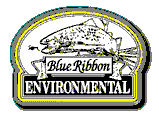





























By Tim Oldfield, (1997)
Avocational Graphics and WebGuy
(click on Tim's name to jump down to his personal paragraph)
Note: These questions and answers are for us folks who may have hopped on the web-wagon at a time when a few million others were taking certain terms and techniques for granted... or at least pretending they were in-the-know. We are learning a few new things ourselves. So, please forgive us if this graphic intensive site doesn't load fast or totally in line on you browser program. However, you are encouraged to inform us of undesirable events. We'll attempt to correct things until it all reads as well as possible on as many browser-types as we can manage... one at a time.
1. What's our URL address?
It's "www.bre-products.com". And "URL" is the acronym for "Uniform Resource Locator", and that means Internet or Web Address. You needed it in some form to get here... perhaps typed out or as a hidden code in a hypertext link. It follows the "http:/" (HyperText Transfer Protocol) on your browser program's address line.
You probably knew what that "www" on the first part of our URL is. Well, it wasn't a third World War, nor a triple set of cloned double ewes. It's another acronym... World Wide Web, also known more concisely as "the Web" or "the Internet", (not to be confused with "Intranet" which is usually only accessed by networked computers of a specific company) nor "Extranet" (specific companies networked together). On very rare occasions, the Web is also called "The Information Highway". You've probably noticed that not all URLs start with the "www" and they don't always end in "com". Generally, "com" = commerce or personal site; "net" = internet commerce too it seems; "org" = not-for-profit organization; "gov" = federal government... Expect to see several formats evolving. The internet is still very much in its early years.
2. Is it true that each viewer's computer and "browser program" may DISPLAY the web-site differently?
Unavoidably, Yes. Part of the intent behind HTML coding is to adjust text and/or images to display as well as possible on various sizes and types monitors possibly custom set to individual viewer choices (i.e.: high contrast, large font/text viewing for vision impaired web surfers) and differing operating systems, old and new. The view also changes with differing web-viewing "browser" programs like Netscape Navigator or Microsoft Internet Explorer, Opera Software, etc. Also, the user's custom setting may alter the intended layout... text/font-styles, colors, sizes, how the graphics load, if at all, and more. Some of the challenge is to please as many of the variables as possible while having things display acceptably to both the web-site owner and the net surfer.
While we are creating our web pages, we "preview" them on differing monitor screen sizes. We also preview in fairly common browser editions (the FREE Downloadable versions) of Netscape Navigator v2.02 (newer versions, like Netscape Communicator, are often FREE too, and downloadable from www.netscape.com), Microsoft Internet Explorer v3.02 (for newer versions of I. E., look at www.microsoft.com) and Opera v3.10 (at http://www.operasoftware.com/, a compact program with several nice features from Norway).
Tip: If your browser seems to have frozen or have trouble getting all of the graphics or other information to load on your screen... try clicking on the browsers "stop" button a few times and then click "Reload" to let it attempt again to finish the job. Your browser may use synonyms or images (icons) to indicate "Stop" & "Reload" or "Refresh". I have confidence that you'll figure out which buttons or words to click on. If not, try "Help" on your menu... and pray that you can guess which term the technical writer thought you should be searching for to accomplish the task you desire.
3. Is this site written in HTML codes?
For the most part, Yup. HyperText Markup Language was, as I understand it, created by some very bright folks in Europe with wonderful ideas about sharing a standardized format of information dissemination which could be used by folks all over this planet via the Internet. The standard is not always closely adhered to. Some browsers creatively add to the list of commands.
Some parts of a website might be written in Java script, Perl script, etc.
The web authoring or editing program we primarily used to do the original development (through 1997) of this site was HoTMetaL version 2.0 from SoftQuad (http://www.softquad.com/). We started using the newer 4.0 version in January, for 1998 site improvements. It was more user-friendly, with the three viewing options... straight "HTML Source" (with colored codes), "Tags On" (like we saw in version 2.0), and a more WYSIWYG (pronounced "wizy-wig" or What You See Is What You Get) look to reduce unwelcome nasty little surprises upon previewing... at least on some browsers.
To see a sample of what HTML coding looks like... you may be able to place your mouse cursor over the background area (not on an image or text), then "Right-Click" (some people call it the less often used "outside mouse button") to see an alternate menu. Look for a choice called "View Source" (or similar sounding words) and click on it. If you don't have that choice in your browser program, look in the regular top menu, perhaps under "View" and then "View Source" (or simply "Source", or "Frame" and then "Source", or whatever synonymous terms may be used in your browser). A program such as "Note Pad" should open and reveal the code for this page. Cool looking Huh?
4. Did you use an FTP get your HTML files to your ISP?
Right again. A File Transfer Protocol program was used to upload our HyperText Markup Language files to our local Internet Service Provider (sometimes referred to as the on-ramps to the information highway).
The FTP program used in January of '98 was CuteFTP version 2.0 (http://www.cuteftp.com/). Our ISP is IceHouse Net Services (http://www.icehouse.net/) of Spokane, Washington, U.S.A., with Dean and his helpful, friendly staff. IceHouse was the first ISP in this region to have the new true ADSL (Asymmetric Digital Subscriber Line) technology. They have grown and added a couple more offices in other cities since we first moved our site to one of their servers.
5. What are "GIF" and "JPG" or "J-Peg" images?
Graphics Interchange Format is a handy compression method for limited-color-range images. It boasts no loss of quality after repeated compressing and uncompressing. Animated images and graphics with a portion of the area as "see-thru" or "transparent" are probably done as GIF images.
Joint Photographic Experts Group compression is usually preferred for more natural-color images with millions of colors. At the time of this writing, GIF and JPG are the most common graphic image formats.
6. What are Internet "Cookies"?
I'm not real sure (I didn't say I could answer all questions). The best I can guess by the most common use of the euphemism, "Cookies" are a little piece of information sent by a web server to your web browser and expected to be saved on your hard-drive to return information to the server whenever the browser makes additional requests of the server. The information exchange, (perhaps like magazine reader service cards), may be helpful in some ways to some people.
If you do much research on the Internet, you may find yourself getting a dozen (more or less) "Cookie" warnings at each site or (or even each page) telling you something to the effect of... "this site may not view correctly..." if you don't accept them. (I find most sites seem to view fine without accepting them... Some Java Scripts may be impaired. Some browsers are preset in the "options" or "preferences" not to warn you, or to warn you about the cookies. I usually prefer to let them go without the warnings, 'cause it is time consuming to fight them by not accepting each and every one individually. It is interesting to choose to be warned, just to see how pervasive they are, for one day.
The term "Cookie" sounds as if someone may be using candy to pry information from an innocent little computer without always having the owner's conscious permission and without divulging the complete nature of the implants. I've been told these cookies can't snoop on your hard-drive, (quietly sending personalized or gleaned information back to cookie owner). I don't think they can... yet. Besides, someone is always coming out with security programs to put the situation in balance after abuses arise.
Are cookies part of what leads to an increase in junk e-mail? It seems so... but perhaps I should check into that too... some other day?!
7. Animal images on your site have links to surprise files... what kind of files?
We have several surprise sound wave files (wav) linked to images throughout our web-site. For Example: go to the All-Terrain page and click on the Elk Image to download a small file that can then play a pre-recorded Elk's Bugle.
If you are using an early Netscape browser, you may get a message asking if you want to "choose application", which will in turn let you choose the executable (exe) program file with which to play the sound file. If you are running with Microsoft Windows '95, most likely you will choose "Sound Recorder" (Sndrec32.exe) usually found in this hard-drive path: C:/Windows/Sndrec32.exe. With newer browsers like Microsoft Windows '98 with Internet Explorer, or Netscape Communicator Pro, they should load and play just fine.
8. What other computer graphics programs do you like to use?
There are a lot of programs I have yet to try out that I'm sure I would like. Here are some of the ones that I like now (they may or may not be my favorites after I get a chance to use others):
CorelGraphics Suite... mostly CorelDraw v6 (rebuild/revision B176) and Corel PhotoPaint. I also use the version 7 for some work... haven't tried 8 yet. Note that I also like Adobe Illustrator and PhotoShop, just happened that Corel fit into my budget easier. I'd also like to take the time to try out the latest of Macromedia's FreeHand Suite... one of these days.
9. What does Timothy
do when not tied to the computer? 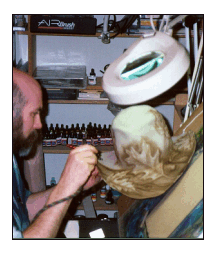 Although doing
digital photo-retouching and web graphics on computer keeps Tim
busy. He sometimes gets to spend a bit of time dining or movie
viewing with friends. On more rarified occasions he may go
camping and canoeing.
Although doing
digital photo-retouching and web graphics on computer keeps Tim
busy. He sometimes gets to spend a bit of time dining or movie
viewing with friends. On more rarified occasions he may go
camping and canoeing. 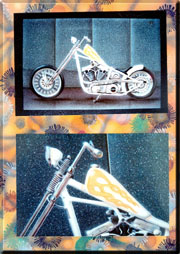 Airbrush illustration on various surfaces is
something he has found myself doing over more than a quarter century
(having worked in sign painting, offset printing, advertising, etcetera,
since the early 1970s). He has also been known to teach Airbrush
Painting and Masking Theory classes, private in-home-or-shop tutorials
or collaborative airbrushing projects in the recent past. He says it seems
to have become more of a dilettante's hobby with the cleaner option of
computer airbrushing for illustrations meant for his AstroGrafix.com high-impact-style
printed cards ( BusinessCards, TradingCards, PostCards, RackCards,
LineCards, BrochureCards and such). Among the seven+ airbrushes he
currently owns, his favorites are the little gravity-fed Paasche V-jr (its
red handle barely visible in the photo at above left) and the siphon-fed
Iwata Eclipse. He has painted on surfaces as large as tractor-trailers and
building-walls to as small as a thumb-tack... also including hard-hats,
welder's hoods, boats, automobiles, clip-boards, stationary, clothing,
fingernails, skin, Native American ceemonial rawhide drums, guitars,
pick-guards, wooden collector fruit crates, mailboxes, etcetera.
Airbrush illustration on various surfaces is
something he has found myself doing over more than a quarter century
(having worked in sign painting, offset printing, advertising, etcetera,
since the early 1970s). He has also been known to teach Airbrush
Painting and Masking Theory classes, private in-home-or-shop tutorials
or collaborative airbrushing projects in the recent past. He says it seems
to have become more of a dilettante's hobby with the cleaner option of
computer airbrushing for illustrations meant for his AstroGrafix.com high-impact-style
printed cards ( BusinessCards, TradingCards, PostCards, RackCards,
LineCards, BrochureCards and such). Among the seven+ airbrushes he
currently owns, his favorites are the little gravity-fed Paasche V-jr (its
red handle barely visible in the photo at above left) and the siphon-fed
Iwata Eclipse. He has painted on surfaces as large as tractor-trailers and
building-walls to as small as a thumb-tack... also including hard-hats,
welder's hoods, boats, automobiles, clip-boards, stationary, clothing,
fingernails, skin, Native American ceemonial rawhide drums, guitars,
pick-guards, wooden collector fruit crates, mailboxes, etcetera.
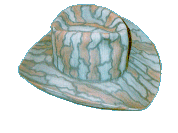
Oh yes, he also likes to dabble in World
Peace on the local household level.
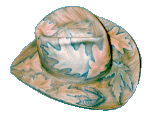 These and other
cowboyhats were airbrushed for B.R.E.'s Environmental Director
(Gary).
These and other
cowboyhats were airbrushed for B.R.E.'s Environmental Director
(Gary).
You may e-mail Tim at Tim@AstroGrafix.com
10. What is that E-Mail Address for Larry Snyder again and how do I send him an E-Mail?
You may send "Electronic-Mail" to Larry at B.R.E. by clicking on this link: webguygonefishing@bre-products.com (and be patient, he's a very busy guy too) or, if it's more urgent, phone Larry directly at the B.R.E. Warehouse at (509) 489-1704.
This link action should target and open your computer's associated default e-mail program or the e-mail feature on the browser program you are using. It ought to automatically fill in the mailing address in the "To:" section. You can type a few definitive words in the "Subject" section and then a message in the area usually provided below that.
The Internet will prove to be a very adventuresome place to visit
and fascinating to create for during the immediate future. Thank you for visiting!

